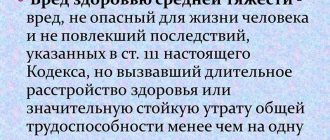ST 111 of the Criminal Code of the Russian Federation.
1. Intentional infliction of serious harm to health, dangerous to human life, or resulting in loss of vision, speech, hearing or any organ or loss of organ functions, termination of pregnancy, mental disorder, drug addiction or substance abuse, or resulting in permanent disfigurement a person who has caused a significant permanent loss of general ability to work by at least one-third or a complete loss of professional ability to work, known to the perpetrator, is punishable by imprisonment for a term of up to eight years.
2. The same acts committed: a) against a person or his relatives in connection with the performance of official activities by this person or the performance of a public duty; b) in relation to a minor or another person who is known to be in a helpless state by the perpetrator, as well as with special cruelty, humiliation or torture for the victim; c) in a generally dangerous manner; d) for hire; e) for hooligan reasons; f) for reasons of political, ideological, racial, national or religious hatred or enmity, or for reasons of hatred or enmity towards any social group; g) for the purpose of using the victim’s organs or tissues; h) with the use of weapons or objects used as weapons - is punishable by imprisonment for a term of up to ten years, with or without restriction of freedom for a term of up to two years.
3. Acts provided for in parts one or two of this article, if they are committed: a) by a group of persons, a group of persons by prior conspiracy or an organized group; b) in relation to two or more persons, - c) has lost force, shall be punished by imprisonment for a term of up to twelve years, with or without restriction of freedom for a term of up to two years.
4. Acts provided for in parts one, two or three of this article, which through negligence resulted in the death of the victim, are punishable by imprisonment for a term of up to fifteen years, with or without restriction of freedom for a term of up to two years.
Causing harm to human health
Causing harm to human health includes a number of actions that entailed a deterioration in the physical status of a citizen.
General characteristics of the crime
Causing harm to human health means that the citizen against whom the crime was committed has lost his sight, hearing or speech ability. Also, under Article 111 in Russia, actions that cause the loss of an organ (or loss of its function), as well as termination of pregnancy, the emergence of addiction to drugs or toxic substances, or mental disorder in the victim, are punishable.
The article implies punishment for facial disfigurement, as well as loss of the victim’s ability to work (both full and partial).
All these actions are punishable by imprisonment for a maximum term of 8 years. This period may be reduced if any mitigating circumstances are found.
The actions described above can be committed with aggravating circumstances:
- in relation to a person who was performing his official duty (for example, in relation to a policeman who was on duty),
- in relation to a child or person who did not have the opportunity to stand up for himself,
- with particular cruelty, causing suffering to the victim,
- a person who was hired to commit a crime,
- for hooligan reasons,
- in order to use the tissues or organs of the injured person,
- with the use of weapons.
In such situations, the term of imprisonment increases to ten years.
When a crime is committed by several people in conspiracy or against a group of people, the term of imprisonment is twelve years.
Object and objective side
The object in the case of Article 111 of the Criminal Code of the Russian Federation is the health of the citizen. If a person has committed a criminal act in relation to his own health, this is not considered a violation of the law (provided that the motive for the action was not an attack on other objects). For example, suicide is not covered under this article. But if a person tried to harm himself in order to avoid military service, his act becomes a crime.
Another example is the criminal abortions that some women performed on their own during the period when medical termination of pregnancy was prohibited at the request of the expectant mother. Fortunately, the anti-abortion law was repealed in 1954, which significantly reduced female mortality.
Read also: Removal of the thyroid gland: what disability group is given?
If a citizen has expressed consent to harm to his health, the act is also not considered a crime. The exception is clandestine abortion. The law also regulates cases in which human organs and tissues are illegally removed without his consent (or without the consent of his relatives or legal representatives).
IMPORTANT! If one athlete causes harm to another during a sporting condition, this is not considered a crime if the participants in the competition were aware of the potential risk and the rules of the sport were not violated. If the rules were violated or a plan was identified in the athlete’s actions, the act falls under the scope of the article.
The subject and subjective side of the crime
The subject in Article 111 of the Russian Federation is a person who is declared sane and has reached the age of 14 years. It may seem that this age is quite small, but already in adolescence a person must realize that certain of his actions can entail serious consequences for the health of another person.
By the age of 14, a teenager must understand what he is depriving the victim of, so he can be punished for the action committed.
Sanity presupposes the absence of mental disorders, both temporary and permanent.
The subjective side of a crime is the presence of intent on the part of the offender.
Intent is awareness of the danger of one’s act, as well as the ability to foresee its consequences. If intent is defined as direct, it means that the offender understands that the onset of consequences for the victim is inevitable. Indirect intent is awareness of the possibility of such consequences. Direct intent involves the involvement of the will of the criminal: he wants to cause harm to the health of another person and consciously commits actions that are aimed at realizing this goal. With indirect intent, such consequences are assumed, but they are optional for the criminal or he treats them with indifference.
IMPORTANT! Intention can be either sudden or deliberate. In the first case, the desire to cause harm arises immediately before it is caused. In the second case, the criminal considers a plan to inflict grievous bodily harm, lies in wait for the victim, and prepares everything necessary for the victim to suffer from his actions.
Objective and subjective side
Speaking about the objective and subjective side, one cannot help but say that it includes a list of acts recognized as illegal , and which inevitably entail a train of various adverse consequences for the victim.
For example, they identify harm to health that is considered life-threatening .
For example, this can be brought to a state that borders on life and death.
Also, bringing to such a state can be produced both by the action of the criminal and by his inaction.
Harm to health that is not life-threatening includes illness of some kind, beatings that do not entail a detailed outcome, and so on, up to loss of vision.
A special place on the objective side is occupied by termination of pregnancy, regardless of how long it is.
In the commentary, the legislator established that, regardless of the period the woman was in prison, if the miscarriage was provoked by the actions of a criminal, the harm is considered grave.
If the miscarriage occurred spontaneously due to the physiological characteristics of the structure of the female body , then the criminal is not the cause of grievous harm.
Intentional infliction of grievous bodily harm
In order to classify a crime and assign punishment to the attacker, it is necessary to clearly define the characteristics of the crime.
Concept and signs
Causing harm to health, which is described in Article 111 of the Criminal Code, implies that the offender committed an act as a result of which the victim’s health was seriously harmed (he lost his hearing or vision, the function of any organ was impaired, etc.).
When assigning punishment, it is important to consider how severe the consequences of the crime were for the victim. The following criteria are used for this:
- there is a danger to the life of the victim,
- the nature and duration of loss of performance, which can be either permanent or temporary,
- the duration of the health disorder, if it is temporary.
To determine the severity of harm to the victim’s health, a forensic examination is ordered.
What does harm to health mean?
According to the provisions of the science of criminal law, harm to health is a violation of the complete integrity of the structure of the human body and the functions that it performs as a whole or as a separate organ or tissue of the body. Such disturbances and deviations in the normal physiological development of the human body occur as a result of physical, thermal, biological or chemical effects. This definition is given to us by the criminal law, in this case it means harm to health as a consequence caused to a person as a result of committing a crime.
Certain types of consequences
Article 111 of the Criminal Code of the Russian Federation implies a number of actions that affect the health of the victim. Let us consider in more detail what consequences such crimes can have.
Loss of vision
This category includes both loss of vision in one or both eyes, and a decrease in visual acuity to 0.04 diopters (that is, the victim can distinguish between light and dark or sees fingers at a distance of up to 2 meters). That is, loss of vision does not have to be complete in order for the actions of a criminal to be qualified under Article 111 of the Criminal Code of the Russian Federation.
Read also: Reasons and questions for forensic medical examination of living persons
Loss of speech
These include:
- loss of the ability to speak clearly, that is, in such a way that the victim’s speech is understandable to others,
- complete loss of voice and ability to express oneself.
Hearing loss
This category includes not only complete deafness, but also a condition in which the victim hears speech only when the sound source is located 5 centimeters from his ear.
Morning organ
Organ loss refers not only to the direct loss of a body part, but also to the loss of its function. For example, this may include separation of an upper limb above the elbow or loss of arm function due to paralysis.
Damage to the genital organs means that the ability to have sex, conceive or bear children, etc. is lost. Loss of organs means the loss of an eye or hand.
Abortion
Diagnosis of the causes of termination of pregnancy presents significant difficulties, so doctors of different specialties should take part in the examination. Article 111 of the Criminal Code of the Russian Federation implies that pregnancy is terminated not due to a woman’s illness or accident, but due to the actions of the criminal.
Mental disorder
Mental disorders become the cause of social maladjustment and permanent loss of ability to work. The diagnosis is made on the basis of a medical examination, in which both psychiatrists and narcologists take part (it is possible that a mental disorder may be caused by the influence of any drugs).
Disease of drug addiction and substance abuse
Experts must decide whether there was a one-time use of drugs or whether the victim has developed a persistent addiction that disrupts adaptation. That is, the disease must be already formed so that the actions of the criminal can be qualified under Article 111 of the Criminal Code.
Irreversible facial disfigurement
Establishing the fact of disfigurement is a difficult problem, since this concept relates rather to the sphere of aesthetics. For example, the same injuries in young, middle-aged and elderly people can produce completely different impressions.
The physician must describe the injury and determine its type. At the same time, it is important to decide whether it is possible to eliminate the consequences of disfigurement and make it invisible to others.
Significant permanent loss of ability to work by at least 1/3
This item includes:
- fracture of the shoulder and forearm,
- fracture of the elbow joint,
- femur fracture,
- spinal fractures without damage to the spinal cord.
Special tables have been developed to determine the degree of self-harm and its impact on the victim’s performance. His profession, the time during which his performance will be reduced, and a number of other criteria are taken into account.
Qualifying features
In order to determine the degree of responsibility of the criminal, additional criteria are applied to clarify the elements of the crime.
General concept
Qualifying features are features that either mitigate the severity of the crime or, on the contrary, aggravate it. For example, if a crime is committed in conspiracy with a group of people, this will be classified as an aggravating circumstance. If the criminal turns himself in to the police, his sentence (of course, taking into account other factors) may be reduced.
Read also: Types of arthrosis and their degrees for which a disability group is given
With extreme cruelty
Particular cruelty implies that the offender mocked the victim, caused her torment and tried to act in such a way that the victim experienced suffering. In court, crimes committed with particular cruelty, according to the decision adopted at the Plenum of the Supreme Court of the Russian Federation in 1999, are punished more harshly than other offenses.
For hire
Hiring means that a person who intends to cause harm to the health of another citizen does not act independently, but hires another person. In this case, both criminals are held accountable (the one who directly caused harm to the victim’s health and the one who hired him).
Signs
The object of this crime, as in many others, is human life and, of course, human health .
In the theory of criminal law, signs mean the conditions for committing a crime that are characteristic of one specific composition.
Thus, a sign of serious harm to health is bringing the victim to a state close to death , or even worse, causing him suffering.
This feature is unchanged for this composition.
The acts that this sign can cover are extensive.
So, for example, blood loss, concussion, loss of a child or termination of pregnancy - all these are different consequences that arise from the same symptom.
Intentional infliction of grievous bodily harm resulting in the death of the victim
If, due to harm caused to the health of the victim, his death occurs, the crime is considered in a special way. Let's figure out exactly how.
Concept
Causing grievous bodily harm resulting in the death of the victim implies that the offender created a threat to a person’s life, as a result of which a life-threatening condition developed. In this case, there may be no intent, that is, the offender does not realize that his actions could cause the death of the victim.
Difference from premeditated murder
In a premeditated murder, the offender intends to inflict such injuries on the victim that could cause his death. He is motivated to act in such a way that the other person will die, and all his actions are aimed at achieving this goal. Causing harm to health does not imply this goal.
Difference from causing death by negligence
When death is caused by negligence, the death of the victim is a consequence of the frivolity or negligence of the offender. At the same time, he does not intend to cause harm to health or kill the victim. There is no motive or malicious intent in such crimes, as a result of which such crimes cannot be classified as murder.
Consequences
The threat of causing harm is also a kind of crime, although the responsibility for it is several times less than we would like.
Threat is understood as an application with a promise of reprisal from a specific person to the victim.
The threat of causing grievous harm to health is criminally punishable, so you shouldn’t throw around words left and right.
Sanctions for a criminal who has committed such an act can be very different, ranging from restriction of freedom and correctional labor to actual imprisonment.
Of course, rarely cases in practice when a threat is given a maximum sentence, if given at all, but in some cases, for example, this is not the first such crime, everything is possible.
Causing grievous bodily harm through negligence
Causing harm to health due to the negligence of the offender is considered in Article 118 of the Criminal Code of the Russian Federation. Such crimes do not imply the presence of malicious intent, so they are punishable either by a fine or correctional labor.
If there are aggravating circumstances (for example, the offender was on duty and was obliged to prevent harm to health, but due to negligence did not do this), an arrest for up to two years may be imposed.
Investigation and consideration of criminal cases under Article 111 of the Criminal Code of the Russian Federation
When considering cases under Article 111 of the Criminal Code of the Russian Federation, it is carried out by investigators from the Department of Internal Affairs. The preliminary investigation is being carried out by employees of the Investigative Committee.
Consideration of such cases is quite labor-intensive. It requires not only numerous interrogations and careful collection of evidence, but also forensic medical examinations to determine the severity of the crime, as well as whether the offender committed unintentional or intentional infliction of grievous bodily harm.
Article 111 of the Criminal Code of the Russian Federation and comments to it describe the infliction of grievous harm to health, as well as additional criteria for qualifying a crime. The investigation of such cases is significant complexity, therefore, in order to quickly achieve a fair decision from the courts and the right verdict, it is necessary to attract competent, highly qualified lawyers.
Commentary to Art. 111 Criminal Code
1. The objective side of this crime is expressed in an act that caused serious harm to health.
2. The medical characteristics of serious harm to health are enshrined in the Criminal Code and include: a) life-threatening harm to health, which is determined by the method of its infliction; b) causing consequences specifically designated by law - loss of vision, speech, hearing, loss of any organ or loss of an organ’s functions, termination of pregnancy (this type of serious harm to health differs from illegal abortion in that it is committed by the perpetrator against the will and wishes of the victim ), mental disorder, drug addiction or substance abuse, permanent facial disfigurement; c) significant permanent loss of general ability to work by at least one third; d) complete loss of professional ability known to the perpetrator. The content of these characteristics is disclosed in the Rules for determining the severity of harm caused to human health, approved by Decree of the Government of the Russian Federation of August 17, 2007 N 522, and in the Order of the Ministry of Health and Social Development of Russia of April 24, 2008 N 194n “On approval of Medical criteria for determining the severity of harm harm to human health."
3. Intentional grievous bodily harm should be distinguished from attempted murder. This means that if, as a result of actions aimed at taking the life of the victim, grievous harm to his health was caused, then the act should be classified as attempted murder.
4. By bullying and torment (clause “b” of Part 2 of Article 111 of the Criminal Code of the Russian Federation) we should understand actions that cause additional suffering to the victim (for example, prolonged infliction of pain by pinching or deprivation of food, drink, etc.). The forensic medical expert does not establish the fact of bullying or torture, but he states whether grievous harm to health was caused in this way.
5. In practice, there is a need to distinguish murder from the intentional infliction of grievous bodily harm, resulting in the death of the victim through negligence (Part 4 of Article 111 of the Criminal Code). In case of murder, the intent of the perpetrator is aimed at depriving the victim of life, and when committing a crime under Part 4 of Art. 111 of the Criminal Code of the Russian Federation, the attitude of the perpetrator towards the death of the victim is expressed in negligence. When deciding the direction of the intent of the perpetrator, the courts must proceed from the totality of all the circumstances of the crime committed and take into account, in particular, the method and weapons of the crime, the number, nature and location of bodily injuries (for example, injuries to vital organs of a person), as well as the preceding and subsequent crime behavior of the perpetrator and the victim, their relationship.




